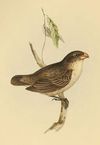Genus Camarhynchus
Mangrove Finch - As its name suggests, the Mangrove Finch lives in the mangroves of the Galápagos Islands. The mangrove finch feeds upon the various insects, larvae, spiders, and vegetable matter found in the mangroves. It closely resembles the far commoner Woodpecker Finch, but is not known to utilize tools.
Woodpecker Finch - It has gained fame due to its capability of using a twig, stick, or cactus spine as a tool. The tool is used as compensation for its short tongue. The finch manipulates the tool to dislodge invertebrate prey such as grubs from trees. The same tool can be used many times on many different trees. Scientists have observed that the finches may shorten the stick or spine to make it more manageable. The finches may also try various sticks or spines at one site before finding just the appropriate one that can reach and extract the prey item.
Small Tree-Finch - Its natural habitats are subtropical or tropical dry forests and subtropical or tropical dry shrubland.
Charles Insectivorous Tree Finch - This species is only found on Floreana Island at elevations above 250m in moist highland forest habitat. Prime breeding habitat is dominated by Scalesia pedunculata trees. It is threatened by habitat loss which has occurred through clearance for agriculture and introduced predators such as rats, mice, cats, and the Smooth-billed Ani. The diurnal Galapagos Short-eared Owl is its only remaining natural predator. The introduced parasite Philornis downsi is a significant threat to the survival of this species. Parasitic larvae of this fly live in the nest material and feed on the blood and body tissues of nestlings. P. downsi causes high nestling mortality in the Medium Tree-finch.
Large Insectivorous Tree Finch - Its natural habitats are subtropical or tropical dry forests and subtropical or tropical moist montanes.



